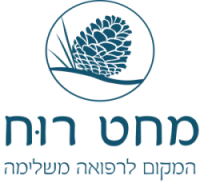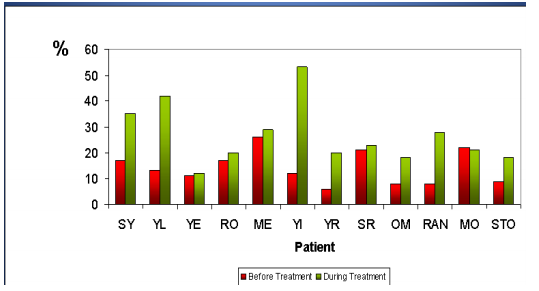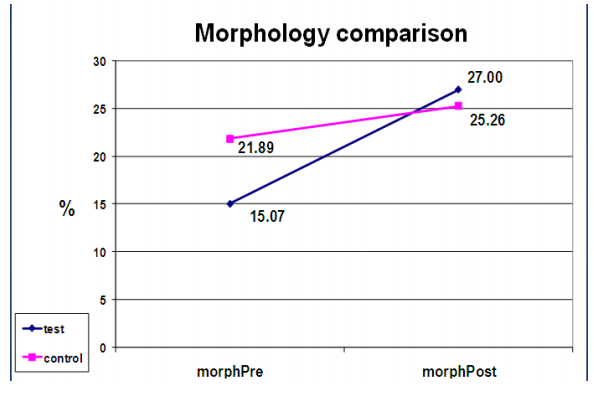T Bello1, NG Cassuto 2, A Ellenbogen 3 , I Barr 4, R Velleman 1 Y Barak 1
1. Center of Complementary Medicine, Kibbutzim College of Education, Tel Aviv,
Israel.
2. Drouot Laboratory, Paris, France.
3. Director of the In-Vitro Fertilization and Fertility Unit at the Hillel Yaffe Medical
Center Israel.
4. Medical Director of International Fertility Medical Center Israel.
Summary
Our study aimed to determine whether a combination of Chinese herbs and acupuncture might
affect sperm characteristics. The study group consisted on 12 patients, who failed to conceive
in at least 3 previous intracytoplasmic sperm injection (ICSI) attempts. Couples were
diagnosed according to the "8 principles" of the Chinese Medicine. Administration of herbs
and acupuncture treatments, were given accordingly. Sperm analyses of each patient were
compared before and during the treatment. Outcomes were compared with sperm
characteristics of 19 patients of the control group, who underwent 2 sperm analyses during 4
months period of time. A higher rate of normal sperm morphology was noticed in the study
group after a mean of 39.58+9.3 days of treatment using a paired T-Test (14.17%+6.4 vs
26.58%+11.7, respectively; t11=-3.365, p<.006. No change was noticed in the rate of normal
forms in the control group (21.9%+10.4 vs 25.26% +10.29). A difference was also noticed in
the volume of the ejaculate after treatment (1.5+ 0.56 vs 2.08+1.16 ml; t11=-2.184 p<0.05).
Additionally, 6 pregnancies were achieved following our combined Chinese treatment with
ART, 5 of which resulted in successful deliveries, 1still ongoing and one ectopic. We
concluded that a combination of acupuncture and Chinese herbs may be a useful, supporting
treatment for males and couples who failed to conceive in IVF, and intend to undergo further
fertility treatments.
Introduction
Sperm quality is undoubtedly of the greatest importance in determining the quality of the
developing embryo (Ménézo and Barak 2000; Loutradi et al, 2007). Several points of negative
impact, both genetic and epigenetic, have been identified due to ICSI treatments of couples
with poor quality spermatozoa (Kruger et al 1986, Menezo and Dale1994; Jones et al, 1998).
ICSI embryos have a lower developmental potential, as measured by blastocyst formation
(Shoukir et al 1998, Miller and Smith 2001, Cassuto et al 2008). It is likely though, that some
of the injected spermatozoa do have a good developmental potential (Hewitson et al,
1997,1999). However, injection of individual sperm cells with abnormal morphology reduced
fertilization and implantation rates (De Vos et al 2003).
Several criteria such as: sperm concentration, rate of normal sperm morphology, volume of
the ejaculate are currently used in routine sperm analysis to evaluate the quality of the the raw
ejaculate. However, sperm morphology probably plays the major role in the outcome of IVF
and ICSI treatments (Kruger et al 1986, Nagy et al 1998, Ménézo and Barak 2000, Bartoov et
al 2002, Hazout et al 2006, Cassuto et al 2008)
Traditional Chinese Medicine (TCM) is known for already 3000 years as an efficient method
for treating various health disorders. The theoretical framework of TCM is based on the
following:
Yin-yang theory – the concept of two opposing, yet complementary, forces that shape the
world and all life.
Qi theory – In the TCM view, a vital energy or life force termed as Qi, circulates in the body
through a system of pathways called meridians. Health is an ongoing process of balance and
harmony in the circulation of the qi. In the TCM, pathologies appear due to internal or
external causes, and /or causes of excess or deficiency. Diagnosis is done by the 4 methods:
interrogating, observing, pulse taking.
Male infertility, in TCM, might, therefore, occur due to excess syndromes:
“Damp heat” accumulating in the lower part of the body; Stagnation of blood and Deficiency
syndromes: kidney jing, kidney and liver yin, kidney and spleen yang (Macioca, 1989).
Following the above our study deals with the integration between the Traditional Chinese
Medicine and the conventional methods for treating, couples who failed to conceive following
traditional treatments of infertility, mainly ICSI (3-15 previous cycles). As previously
mentioned, sperm morphology probably plays a major role in the outcome of IVF and ICSI
treatments. Criteria as sperm concentration, motility, rate of normal forms and volume of the
ejaculate are currently used in routine sperm analysis to evaluate the quality of the the raw
ejaculate. The aim, in the current study was, therefore, to determine the effect of the
combination of Chinese herbs and acupuncture on routine sperm parameters in couples, who
failed to conceive in their previous ICSI attempts
Materials and Methods:
Patients: Study group consisted on 12 couples with male infertility, who failed to conceive in
at least 3 previous ICSI attempts. The control group included 19 patients with male infertility
who underwent 2 sperm analyses within a 40 days period of time, without treatment.
Sperm analysis: Sperm samples were analyzed by light microscope (NikonE200) with sperm
analysis chamber (Sperm Processor, India) .Morphology of sperm cells was diagnosed according
to WHO criteria using TestSimplest Kit (Diagonal, Germany) .Analyses were performed before
and after 40 days ( 39.58+9.3 days ) of the combined acupuncture and herbs treatment .A
comparison of the following sperm parameters: volume of ejaculate, PH, sperm concentration,
sperm motility and morphology, was performed. .These parameters were also compared with the
analyses of the control group.
Strategies of treatments: Were chosen according to the “8 principles": Exterior vs Interior –
Is the disharmony due to internal causes (organs dysfunction\ emotional distress) or due to
external pathogens (micro organisms\toxins\climatic\food intake) ; Cold vs Heat – do the signs
and symptoms shows tendency for heat or cold? Deficiency vs Excess – is there a significant
deficiency (vacuity) of qi blood, yin, jing or yang or a significant excess due to
stagnation\accumulation of the above substances? ; Yin vs Yang – Does the overall picture has a
yang or yin character? (Macioca, 1989)
Most patients continued their ART treatments approximately 1 month after starting their
combined Chinese treatment.
Results
"8 principles" strategy
Two major syndromes were identified in the study group
1. Damp heat in lower body: This syndrome might be due to varicocele or partial obstruction
in the sperm ducts. Major signs and symptoms were tendency/aversion to heat, red
complexion, red tongue-body with thick greasy yellow fur, wiry and rapid pulse.
2. Kidney jing deficiency: In those patients, tendency for low sperm volume, concentration,
motility and morphology was observed. Signs and symptoms observed: Aging, weak and sore
back and knees, loss of hair or gray hair, blurred vision, pale and moist tongue body, weak or
empty pulse in kidney position.
Sperm Analysis
Statistical analysis, using a paired T-Test did not revealed any change in the values of sperm
concentration, motility (Fig 1) and pH before and after 22 to 57 (mean of 39.58+9.3) days of
the combined treatment of Herbs and Acupuncture. However, a higher rate of normal
morphology values was noticed after 39.58+9.3 days (14.17%+6.4 vs 26.58%+11.7,
respectively, t11=-3.365, p<.006) (Fig 2a). Additionally, a significant difference in was
noticed in the volume of the ejaculate after treatment (1.5+0.56 vs 2.08+1.16ml; t11=-2.184
p<0.05; Fig 2b). No change was noticed in the rate of normal forms in the control group
(21.9%+10.4 vs 25.26%+10.29; Fig3) ANOVA for Repeated Measurements indicated a
significant interaction (F1,29=4.467, p<.043).
Conclusion:
A combination of Acupuncture and Chinese herbs may be a useful, non traumatic supporting
treatment for males of couples which failed to conceive in ART (IUI/ IVF/ICSI/ED) and
intend to undergo further fertility treatment.
Further investigation is still taking place
References:
Ménézo Y, Barak Y. Comparison between day-2 embryos obtained either from ICSI or
resulting from short insemination IVF: Influence of maternal age. Hum Reprod 2000;
15:1776-80
Tarlatzis BC, Goulis DG, Zepiridis L, Pagou T, Chatziioannou E, et al. The effects of sperm
quality on embryo development after intracytoplasmic sperm injection. J Assist Reprod Genet
2006:23(2) 69-74.
Kruger TF, Menkveld R, Stander FS, Lombard CJ, Van der Merwe JP, van Zyl JA, et al.
Sperm morphologic features as a prognostic factor in in vitro fertilization. Fertil Steril 1986;
46:1118-23.
Ménézo Y, Dale B. Paternal contribution to successful embryogenesis. Hum Reprod 1994;
10:1326-8.
Jones GM, Trouson AO, Lolatgis N, Wood C. Factors affecting the success of human
blastocyst develoment and pregnancy following in vitro fertilization and embryo transfer.
Fertil Steril 1998; 70:1022-9.
Shoukir Y, Chardonnens D, Campana A, Sakkas D. Blastocyst development from
supernumerary embryos after intracytoplasmic sperm injection: a paternal influence? Hum
Reprod 1998; 13:1632-7.
Miller JE, Smith T. The effect of intracytoplasmic sperm injection and semen parameters on
blastocyst development in vitro. Hum Reprod 2001; 16:918-24.
NG Cassuto, MD Bouret, JM Plouchart, S Jellad, P Vanderzwalmen, M R Balet, L Larue,
Y Barak: A new real-time morphology classification for human spermatozoa: a link for
fertilization and improved embryo quality". online 05 Fertil Steril. 2008 Nov 4
Hewitson L, Simerly C, Schatten G. Inheritance defects of the sperm centrosome in humans
and its possible role in male infertility. Int J Androl 1997;3 (Suppl. 20):35-43.
Hewitson L, Dominko T, Takahashi D, Martinovich C, Ramalho-Santos J, Sutovsky P, et al.
Unique checkpoints during the first cell cycle of fertilisation after intracytoplasmic sperm
injection in Rhesus monkeys. Nature Med 1999; 5:431-3
Bartoov B, Berkovitz A, Eltes F, Kogosowski A, Menezo Y, Barak Y. Breakthroughs in
andrology: Real-time fine morphology of motile human sperm cells is associated with IVFICSI outcome. J Androl 2002; 23:1-8.
Hazout A, Dumont-Hassan M, Junca AM, Cohen Bacrie P, Tesarik J. High-magnification
ICSI overcomes paternal effect resistant to conventional ICSI. Reprod Biomed Online 2006;
12:19-25.
.
De Vos A, Van De Velde H, Joris H, Verheyen G, Devroey P, Van Steirteghem A. Influence
of individual sperm morphology on fertilisation, embryo morphology, and pregnancy
outcome of intracytoplasmic sperm injection. Fertil Steril 2003; 79:42–8.
Nagy ZP, Verheyen G, Tournaye H, Van Steirteghem AC. Special applications of
intracytoplasmic sperm injection: The influence of sperm count, motility, morphology, source
and sperm antibody on the outcome of ICSI. Hum Reprod 1998; 13 (Suppl 1):143–54
Giovanni Macioca in: The Foundation Of Chinese Medicine, Published by Churchill
Livingstone, 1989


